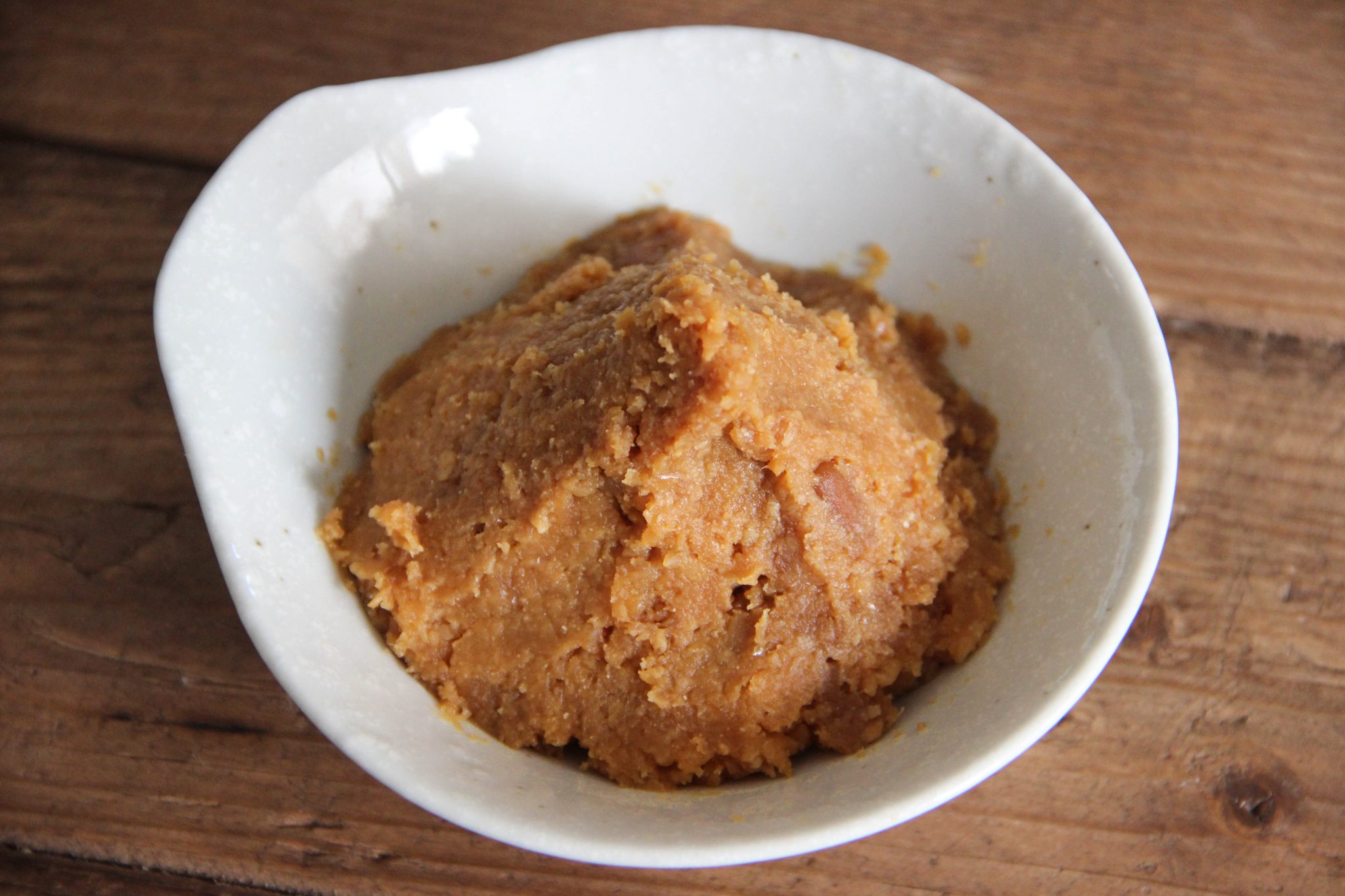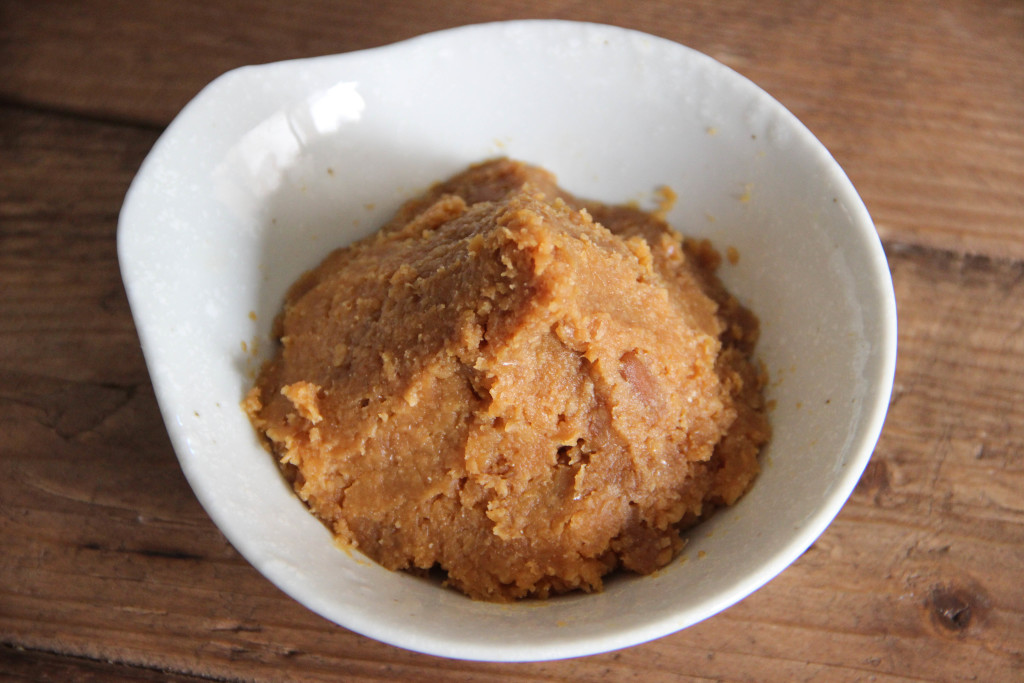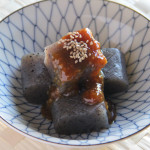Miso is a paste made from fermented soy beans. It is one of the crucial seasonings in Japanese cuisine to make various foods like soups, sauces and other dishes. Miso is quite salty by itself, but dense in Umami (savory) flavor from long fermentation. Japanese food using Miso such as Miso Soup is loved and well known to not only Japanese people but also to people in the whole world today.
The history of Miso in Japan is very long. They say that an original form of Miso started to appear around 300 B.C., and it became closer to today’s Miso around the 6th century. The main ingredients of Miso are soy beans, Koji, and salt. Cooked soy beans are mixed with a kind of mold grown on rice (Kome Koji) and salt and then fermented. Koji induces the fermentation process and gives a great sweet flavor. Salt works to limit undesirable bacteria and mold during the fermentation since Miso is kept at room temperature.
There are different kinds of Miso. Shiro Miso (white) has a sweeter and milder flavor, while Aka Miso (red) has a saltier and mature taste. Ingredients for white and red Miso are mostly the same, but the colors and flavors develop differently depending on the amount of salt and fermentation time. White miso is preferred in the Kyoto region which is in western Japan, and red is more popular in central Japan, but Awase (mixed) is used more generally all over Japan. In some other regions, they also make Miso mixing in rice or barley.
Today not too many people make hand-made Miso anymore since you can buy it so easily from supermarkets everywhere, even in the US. Considering how long it takes (1-2 years) for the whole process, we understand a lot of people opt to buy it at stores; however, it is quite easy and fun to make your own Miso and to watch how it develops. Besides, you can tell people you are making your own Miso, and that sounds pretty impressive. It will take a long time to be able to taste it, but it is well worth the wait. With a little work and one year, you’ll have Miso you’ll be proud of!
(Also, please be careful to keep everything very clean and inspect the food while making Miso (similar to canning). The fermentation process is long and not refrigerated. While the technique explained in this recipe is traditional, it may not always work well for all equipment and environments. Be sure to use your best judgment when deciding the Miso is ready and acceptable to eat. Be safe and you will enjoy a taste of traditional Japanese cooking!)

Miso Recipe
Ingredients
- 2 cups dried soybeans (using a 240ml-cup)
- 5 cups water
- 12 Tbsp sea salt
- 3 cups granular rice Kouji (using a 240ml-cup)
- Shochu or vodka
Instructions
- Rinse soy beans. Put soybeans and water in a pressure cooker and let soak overnight (without heat, at least 8 hours).
- Clean a container in which the Miso will be kept. Wipe inside with Shochu or strong liquor like vodka.
- Put the pressure cooker on the stove, heat, and bring to full pressure. Reduce heat to low, and simmer for 30 minutes. (If you don't have a pressure cooker, cook in a regular pot for 3-4 hours until very soft.)
- Release the pressure, open the lid (carefully), and strain, but reserve the cooking water.
- Put cooked beans in a food processor and make a smooth paste with some small pieces.
- In a large bowl, mix bean paste, 10 Tbsp of salt, and rice Koji very well. If the mixture is too dry, add bean water a tablespoon at a time. Make balls of paste, squishing well to remove any air inside. Then pack the balls in the prepared container. Push well, make the surface flat, and sprinkle on 2Tbsp of salt. Place a sheet of plastic wrap over the Miso, and make it stick to the surface of the Miso.
- Put a weight weighing at least 1kg, such as a bag of salt or stone, on the Miso, and leave for 1-2 months in a cool dark place. Removing the weight and plastic, check the surface of the Miso and remove any mold. Wipe the inside of the container with Shochu liquor again, sprinkle some salt on the Miso, cover with plastic, and put the weight back in place. Leave for another 4 months checking sometimes for mold (and removing any as described here).
- The Miso could be done in about 6 months, but better to leave for a year or longer. You could keep refrigerated after that.



1 Comment
Wow, I really want to try this! Too bad I don’t currently live in a place where I’m sure I’ll be for 1-2 years. But I’ll try to remember.
I have a question though, is the 12tbs salt a recommendation or a must? Or can it be decreased, or even eliminated, depending on taste? I’m asking because too much salt isn’t really healthy for blood pressure. And I think it would be interesting to try miso that tastes less salty (though I also love the salty miso flavor of course). Would 0 salt still make usable miso?
Thanks!